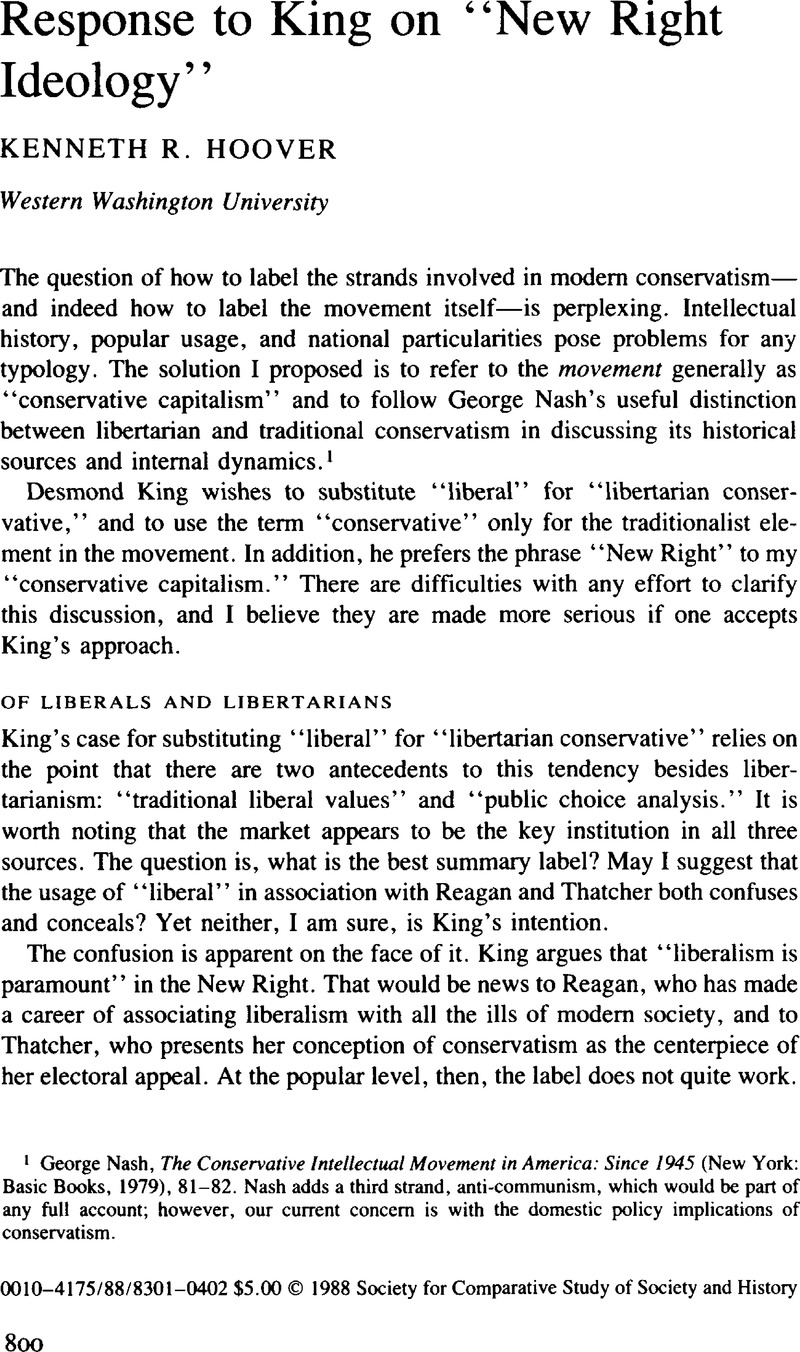No CrossRef data available.
Article contents
Response to King on “New Right Ideology”
Published online by Cambridge University Press: 03 June 2009
Abstract

Information
- Type
- CSSH Discussion
- Information
- Copyright
- Copyright © Society for the Comparative Study of Society and History 1988
References
1 Nash, George, The Conservative Intellectual Movement in America: Since 1945 (New York: Basic Books, 1979), 81–82. Nash adds a third strand, anti-communism, which would be part of any full account; however, our current concern is with the domestic policy implications of conservatism.Google Scholar
2 See the works of James Buchanan, Murray Rothbard, and Robert Posner, for example—all of whom are frequently cited by conservatives in modern politics, not liberals. Cf. Benjamin Ward, The Conservative Economic World View (New York: Basic Books, 1979), pp. 102–12.Google Scholar
3 The American side can be documented by any book on the domestic politics of the last forty years; see Hoover, Kenneth, Ideology and Political Life (Monterey, CA: Brooks-Cole, 1987)Google Scholar, ch.5. For an example on the British side, see Britain United: The Time Has Come, the SDP/Liberal Alliance Programme for Government, 05, 1987.Google Scholar
4 The larger national issue is that, in Britain, conservatism was confronted mainly by a mild form of socialism, or social democracy, rather than, as in the United States, a reformist version of liberalism. Consequently the term “liberal” is available for use, though, for the reasons indicated here, I think it is historically inaccurate and risks confusing the popular discussion. Cf. Green's, David interchangeable use of “new libertarianism” and “new liberalism” in his The New Conservatism, first published as The New Right in Britain, (New York: St. Martin's Press, 1987), 213–217.Google Scholar
5 See, for example, the use of this phrase in Kenneth, and Dolbeare, Patricia, American Ideologies: The Competing Political Beliefs of the 1970s (Chicago: Rand McNally, 3rd ed., 1976), 57–62.Google Scholar
6 For other sources on these splits in Britain, see Hoover, , “The Rise of Conservative Capitalism: Ideological Tensions within the Reagan and Thatcher Governments,” CSSH, 29:2, 248Google Scholar, note 7. For current indicators of the political significane in the United States, see “High Tide for Conservatives, But Some Fear What Follows,” The New York Times, 13 10 1987, 1Google Scholar, 10; and the division between “enterprisers” and “moralists” in Republican ranks reported in a Gallup interview survey, in Norman Omstein, “How to Win in '88: Meld the Unmeldable,” U.S. News and World Report, 12 10 1987.Google Scholar
7 Hoover, , “The Rise of Conservative Capitalism,” 268.Google Scholar
8 For further analysis, see Hoover, Kenneth and Plant, Raymond, Conservative Capitalism in Great Britain and the United States: A Critical Appraisal (London and New York: Routledge Ltd., 1988).Google Scholar

